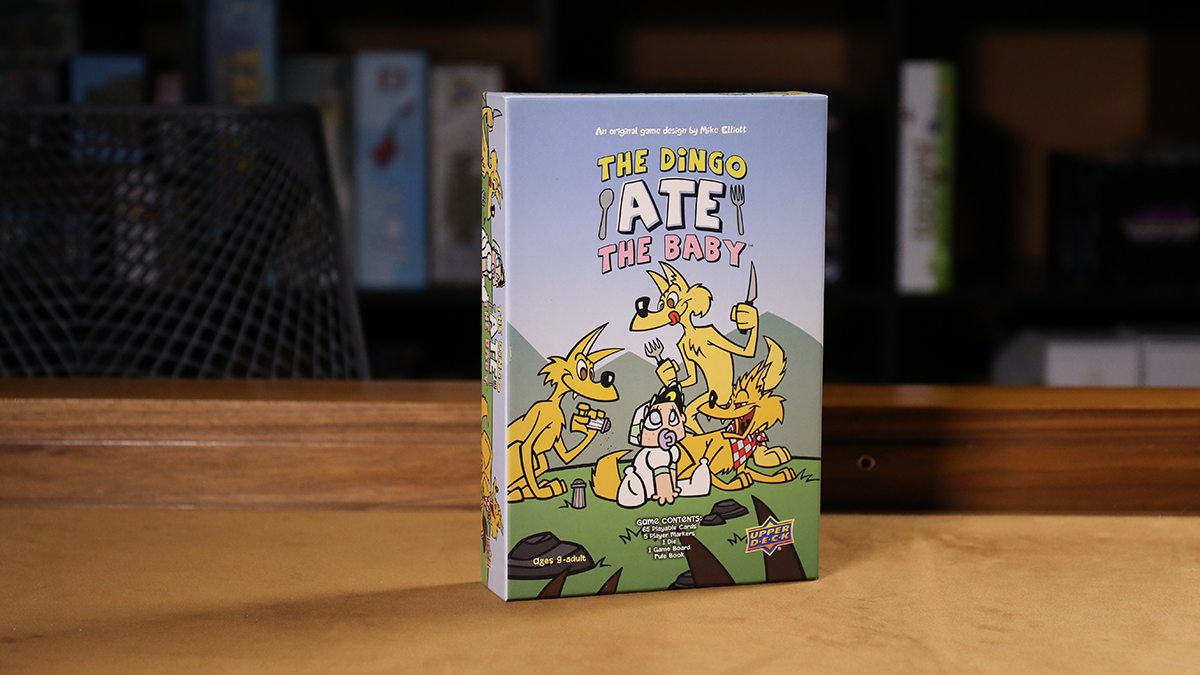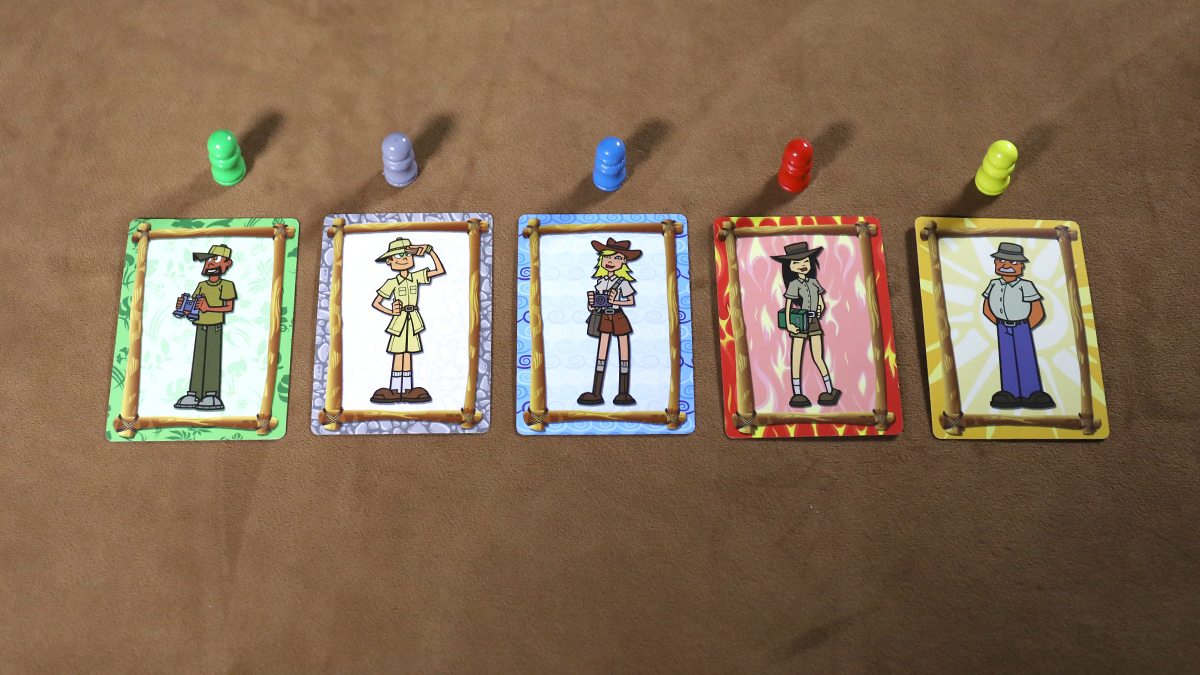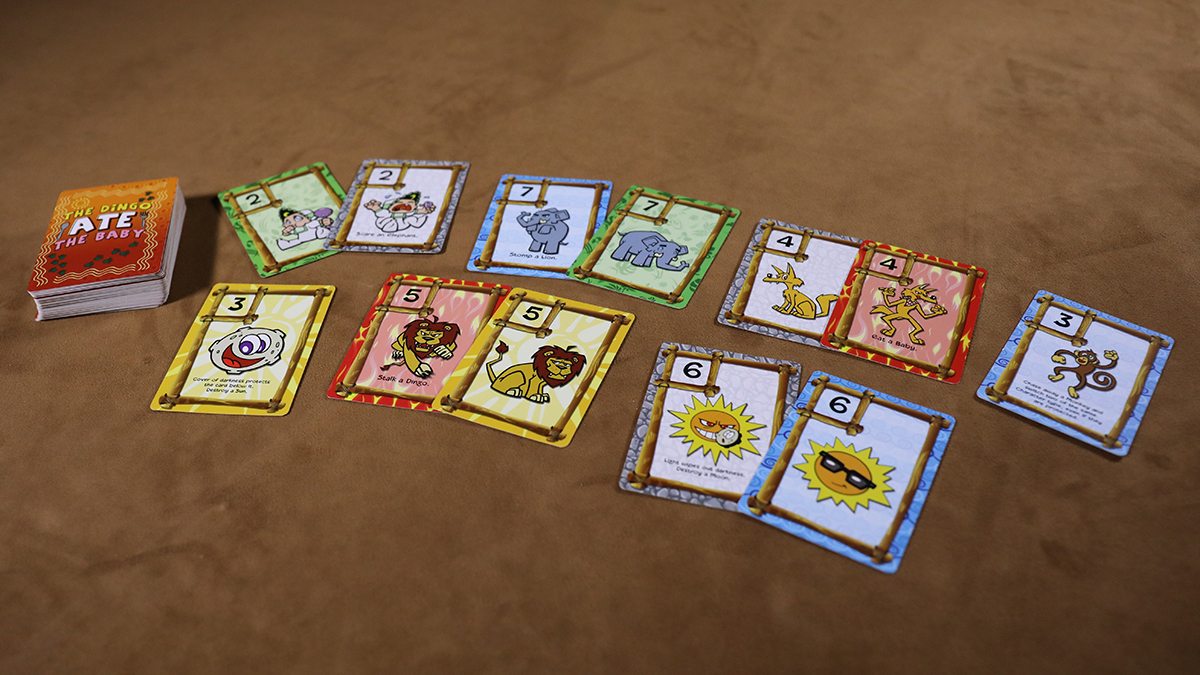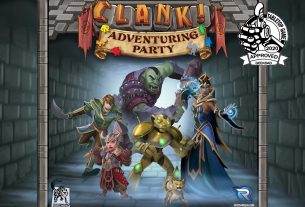What’s The Dingo Ate the Baby About?
In 1982, a family was camping near Uluru in the Northern Territory of Australia. During the trip, their child disappeared. The mother said the baby was carried off by a dingo, a wild dog. Authorities didn’t believe her and both parents were arrested. The mother spent three years in prison, but during the trial, evidence was introduced that exonerated the parents. The child, it seemed, had indeed been carried off and killed by dingoes.
For some inexplicable reason, this horrible and tragic story hit the public mainstream and the idea of a dingo eating a baby has been used in popular culture, showing up in Seinfeld, The Simpsons, and other cultural touchstones, as a comical punchline. Now it’s the name of a game. The game doesn’t specifically spell out a connection to the story, but it’s essentially rock, paper, scissors with dingoes eating babies as part of the rubric. The Dingo Ate the Baby is a game for 2-5 players, age 9 and up, and plays in less than 30 minutes.
The Dingo Ate the Baby Components
In the box, you’ll find:
- 60 Cards for the play deck
- 5 Starting player cards
- 5 Score markers
- 1 10-sided die
- 1 Game board
The cards are good quality and widely colorful. Each play deck card has a character on it, a number, and, sometimes, an effect. The characters fall into one of seven categories: elephant, lion, dingo, monkey, baby, sun, and moon. Each card also has a value on it, unique to that character type. There are five monkeys, five moons, and ten of everything else. Of the characters that have ten cards, five of each character cards will have an effect and five will not. The artwork is cartoonish and playful and generally pretty good, although some of the backgrounds feel out of place with the theme.
The score markers are wooden pawns, color-coded to the backgrounds of the player’s starting cards. The game board is about an inch larger in both dimensions than an A4 sheet of paper. It’s on stout cardboard and the playing area is encircled by a scoring track of rocks, mostly; one is a bridge. In the center, there is a pile for drawing and another for discards. The D10 is a D10. It looks like something fresh off of an attack roll.
How do you play The Dingo Ate the Baby?
Setup
Setup is easy. Each player gets a starting player card and a corresponding scoring marker, which is placed on the start point of the scoring track. The play deck is shuffled and then placed face-down on the indicated draw portion of the board. A starting player is chosen and that player will deal the first round. You are ready to play.
Gameplay
The first step of each round is to roll the D10. Add seven to the result and this is the target number for the round. Players attempt to play cards in front of them that equal (or get close to) the target number without exceeding it.
The starting player then deals a single card face-up and then two cards face-down to each player. The face-up card is the beginning of what is called each player’s “ranch” and is placed just to the right of the player’s starting cards. This means that card is protected and may not be affected by other players. On a player’s ranch, any time that a card is removed, any remaining cards are slid left toward the player’s starting card.
Play then begins with the starting player who may perform one of the following actions:
- Play a card of any color onto your ranch — The card goes to the right of your protected card or any cards already on your ranch. You may also (but do not have to) resolve any effect that the card grants.
- Play a card onto an opponent’s ranch — The card must be placed to the right of any cards on the opponent’s ranch and must match either that player’s starting card or the color of a card already on that player’s ranch. If the card has an effect, you may decide if you want it to trigger or not.
- Destroy your protected card — You must have at least one additional card (something to slide in to take the protected card’s place). Place the old protected card in the discard pile.
- Discard a card — From your hand, trash a card. This helps to speed up the day (more on that in a moment).
At the end of your turn, draw back up to a hand size of two cards. A couple of special rules also apply. If you play a card onto your ranch that matches the color of your player starting card, you may also trash your protected card. Additionally, when playing a card on another player’s ranch that trashes a card (e.g., lion stalks a dingo), you decide what the target is and it can be an appropriate card on any player’s ranch—not necessarily the player who you played the card on. Again, you may or may not choose to resolve the effect of any card you play.
In game play, babies (worth 2) can scare elephants, elephants (value of 7) stomp lions, lions (5 points) stalk dingoes, and dingoes (value of 4) eat babies. Additionally, the sun (worth 6) destroys any moon and moons (3) protect the card below it and destroy suns. Last is the monkey (value of 3). The monkey can switch two of the same character type, even if they are protected.
Play continues until the number of discarded is equal to the number of players, times two. This ends the day and scoring commences. The player with the highest ranch value, without going over the target value, gets one point for each of the players they beat. Also, a player in second place gets a point for each player they beat, and so on. Any player who exceeds the target score gets no points. The first to the finish line (15 points) wins!
Why You Should Play The Dingo Ate the Baby
The Dingo Ate The Baby is a fun little game with a twist to rock, paper, scissors. By having to try to meet, but not exceed, a target value, the game adds a nice upgrade to the classic game.
There is a fair amount of take-that in being able to play cards onto other people’s ranches. Near the end of the round, you can turn into a dingo-eared assassin and play a big card that pushes a player far beyond the targeted value. But you wouldn’t do that, would you? Some of the effects can also help to ruin someone’s game if you feel like it. However, these are at the discretion of the player. You don’t have to utilize them. Still, the mechanisms also serve to keep games close and they are effective.
One thing we really didn’t care for was the discard pile. Since the round duration is directly tied to the number of cards in the pile, keeping track of them makes the pile concept worthless. We stuck them under the board where they could easily be counted. This could have easily been resolved with a round tracker or something like that. As it stands, we just had an empty area marked “Discard” on the board each time we played. It would have been nice to have a dial or track on the board to remind players what the target value was.
I am personally a bit confused by making a family game that is tied closely to a fairly recent tragedy involving a family. (The mother is still alive, the father died just last year.) It seems distasteful to me. Then again, I reviewed Donner Dinner Party last year and enjoyed it immensely. However, that game has the benefit of a about 175 years of distance on its side. That said, my kids love it and are still breaking out The Dingo Ate the Baby once in a while. It’s easy to teach and play and is a good reminder of math skills.
The Dingo Ate the Baby is out now from Upper Deck and retails for $19.99.
Click here to see all our tabletop game reviews.
If you’d like to stay up-to-date with all of our tabletop gaming coverage, please copy this link and add it to your RSS reader.
Disclosure: GeekDad received a copy of this game for review purposes.








